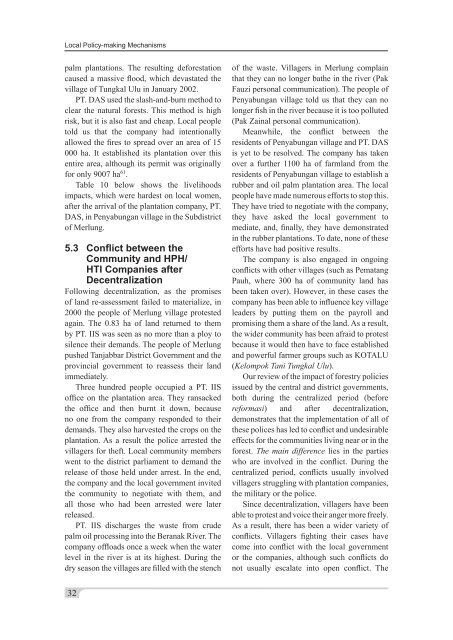Local policy-making mechanisms - Forest Climate Center
Local policy-making mechanisms - Forest Climate Center
Local policy-making mechanisms - Forest Climate Center
Create successful ePaper yourself
Turn your PDF publications into a flip-book with our unique Google optimized e-Paper software.
<strong>Local</strong> Policy-<strong>making</strong> Mechanismspalm plantations. The resulting deforestationcaused a massive flood, which devastated thevillage of Tungkal Ulu in January 2002.PT. DAS used the slash-and-burn method toclear the natural forests. This method is highrisk, but it is also fast and cheap. <strong>Local</strong> peopletold us that the company had intentionallyallowed the fires to spread over an area of 15000 ha. It established its plantation over thisentire area, although its permit was originallyfor only 9007 ha 61 .Table 10 below shows the livelihoodsimpacts, which were hardest on local women,after the arrival of the plantation company, PT.DAS, in Penyabungan village in the Subdistrictof Merlung.5.3 Conflict between theCommunity and HPH/HTI Companies afterDecentralizationFollowing decentralization, as the promisesof land re-assessment failed to materialize, in2000 the people of Merlung village protestedagain. The 0.83 ha of land returned to themby PT. IIS was seen as no more than a ploy tosilence their demands. The people of Merlungpushed Tanjabbar District Government and theprovincial government to reassess their landimmediately.Three hundred people occupied a PT. IISoffice on the plantation area. They ransackedthe office and then burnt it down, becauseno one from the company responded to theirdemands. They also harvested the crops on theplantation. As a result the police arrested thevillagers for theft. <strong>Local</strong> community memberswent to the district parliament to demand therelease of those held under arrest. In the end,the company and the local government invitedthe community to negotiate with them, andall those who had been arrested were laterreleased.PT. IIS discharges the waste from crudepalm oil processing into the Beranak River. Thecompany offloads once a week when the waterlevel in the river is at its highest. During thedry season the villages are filled with the stenchof the waste. Villagers in Merlung complainthat they can no longer bathe in the river (PakFauzi personal communication). The people ofPenyabungan village told us that they can nolonger fish in the river because it is too polluted(Pak Zainal personal communication).Meanwhile, the conflict between theresidents of Penyabungan village and PT. DASis yet to be resolved. The company has takenover a further 1100 ha of farmland from theresidents of Penyabungan village to establish arubber and oil palm plantation area. The localpeople have made numerous efforts to stop this.They have tried to negotiate with the company,they have asked the local government tomediate, and, finally, they have demonstratedin the rubber plantations. To date, none of theseefforts have had positive results.The company is also engaged in ongoingconflicts with other villages (such as PematangPauh, where 300 ha of community land hasbeen taken over). However, in these cases thecompany has been able to influence key villageleaders by putting them on the payroll andpromising them a share of the land. As a result,the wider community has been afraid to protestbecause it would then have to face establishedand powerful farmer groups such as KOTALU(Kelompok Tani Tungkal Ulu).Our review of the impact of forestry policiesissued by the central and district governments,both during the centralized period (beforereformasi) and after decentralization,demonstrates that the implementation of all ofthese polices has led to conflict and undesirableeffects for the communities living near or in theforest. The main difference lies in the partieswho are involved in the conflict. During thecentralized period, conflicts usually involvedvillagers struggling with plantation companies,the military or the police.Since decentralization, villagers have beenable to protest and voice their anger more freely.As a result, there has been a wider variety ofconflicts. Villagers fighting their cases havecome into conflict with the local governmentor the companies, although such conflicts donot usually escalate into open conflict. The32

















